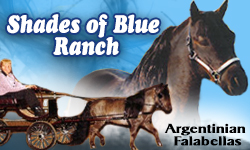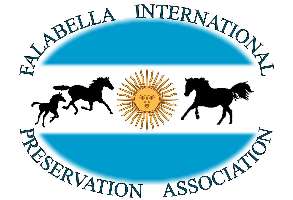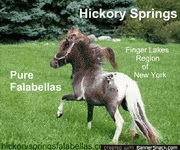The origins of the Falabella are shrouded in mystery.
Some of the legends are more credible than others, in fact one of the more fantastic suggests that these little horses are the direct descendants of Eohippus, the tiny ancestor of all horses!
Here is the version as told by Senor Julio Cesar Falabella:
In the centuries past, Chile and Argentina were colonized by people from various parts of the world, among whom was an Irishman called Newton, a man with a profound knowledge of and passion for horses. The colonist's lives were very difficult and made more so by continuous raids by the native people who set fire to their ranches, killing them and stealing their cattle.
On the river which ran through his land Senor Newton had built a water mill, every night stones were placed inside the mill wheel and the rumbling noise could be heard for miles. The superstitious Indians interpreting this as the magic of evil spirit and kept a safe distance from his ranch!
As the river provided the only water in the area, all the animals came there to drink. Sometimes horses still saddled or even still attached to their carts came...with traces of blood showing that they had been attacked by Indians.
One day a horse came to drink at the river which was quite different from any that Senor Newton had seen before. This animal, thought obviously adult, was tiny but perfectly proportioned: a miniature horse! Fascinated by the tiny stallion, Newton decided to keep him and try to breed him for the pleasure of his little daughter, the future mother of Senor Falabella.
It was the offspring of this stallion that moved Newton's grandson Julio Cesar Falabella to laid, in 1940, the foundation of the Falabella miniature breed.
No one knows the story of that original little stallion that came to drink that day at the river, to whom he belonged, from whence he came and how he came to be so small - this will remain for ever an unsolved mystery.
In 1977, Lord and Lady Fisher, proprietors of the Kilverstone Latin American Zoo (UK), intrigued by the idea of showing the legendary miniature horses at their zoo, visited Senor Falabella at his ranch in Argentina.
Explaining their wish to create the first Falabella Stud in Europe, to their great satisfaction obtained his blessing and permission to choose 4 of his little stallions and several mares.
In the years following, Lord and Lady Fisher made the Falabella known not only in England but in all of Europe, and founded the International Falabella Miniature Horses Society (I.F.M.H.S. www.falabella.Co.uk) with the aim of preserving the authenticity and quality of this rare breed, with the aim of keeping a register of the direct descendants of the first imported Falabellas.
THE BREED AND CARE
But first of all, some useful advice for anyone contemplating having a falabella horse: though small, the Falabella is above all a proper horse so that it needs to be treated as such, not like a dog, or worse, a toy to be given to a child!
Conformation
The Shetland pony, though it has the head and hooves of a "normal" horse, has short legs, wheras the Falabella is a true horse in miniature, perfectly proportioned, with graceful legs, the result of careful breeding.
It is rather like looking at an Arab or a Hunter from the wrong end of a telescope!
Proof that the Falabella is a true breed of its own is that it has 17 vertebrae instead of 18 and a pair of ribs less (Castle Rock note: verified unfortunately by an autopsy on a stillborn foal of ours).
Given their delicate structure they cannot be ridden, but they are marvelous at pulling carts.
Their height is from 79 to 86 centimeters and they weigh about 100 kilos.
Temperament
They have a lovely temperament, they don't bite or kick, they are curious, intelligent and love being brushed and adore human contact.
Looking after the Falabella
As I said at the beginning, the Falabella is to all intents and purposes a horse, and as such requires the same care and maintenance.
There must be a generous space available for it to move about and run; about 300 to 400 square meters of good pasture are sufficient for its daily needs, with the addition of a good armful of hay.
If there is less pasture, or it is below par, it should be supplemented by horse food fodder.
Every year the horse must be vaccinated against flu and tetanus, and should be wormed every spring and autumn.
During the winter the horse's coat gets thicker and longer, so that when the days get warmer it will need brushing and currying, and if necessary, clipping.
The hooves should be checked regularly and clipped when necessary.
At three years the horse is ready to be bred.
Gestation is about 330 days and normally the birth needs no assistance (we have always found the foal as a delicious surprise in the stall in the morning!)
Lovingly looked after, Falabellas can live more than 30 years. Our first stallion lived for 32!
IFMHS
To be entered in the Register of the International Falabella Miniature Horse Society, the horse's height at the withers must not be more than 34" (86 cm) at four year old, as well as having both parents certified.
As it is still a rare breed, be advised that prices start at around 3500 euros.





